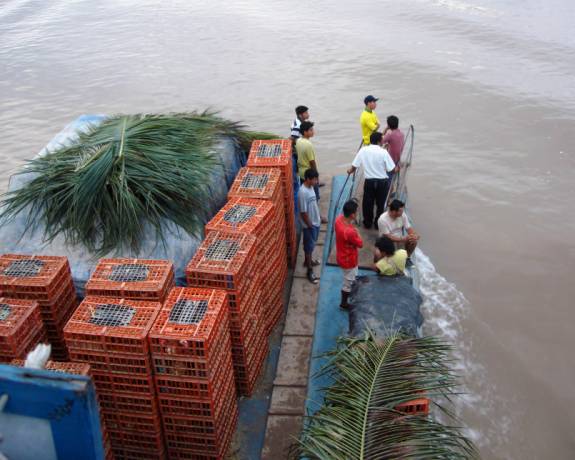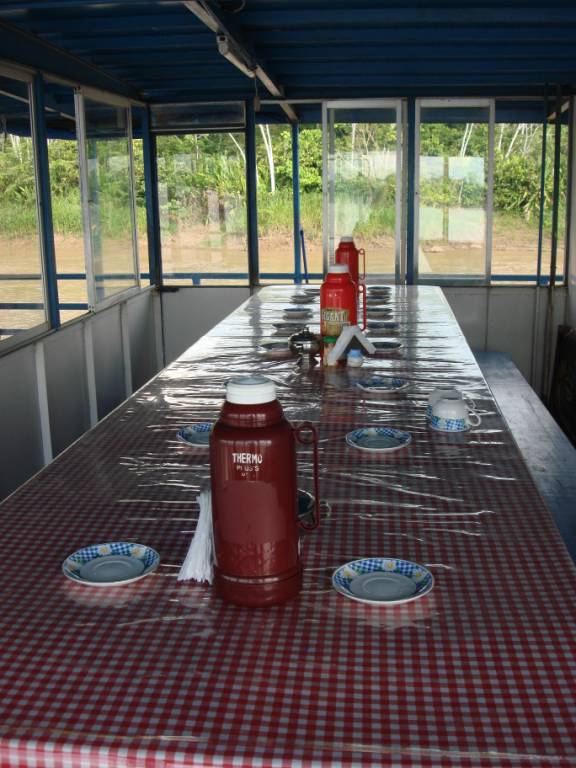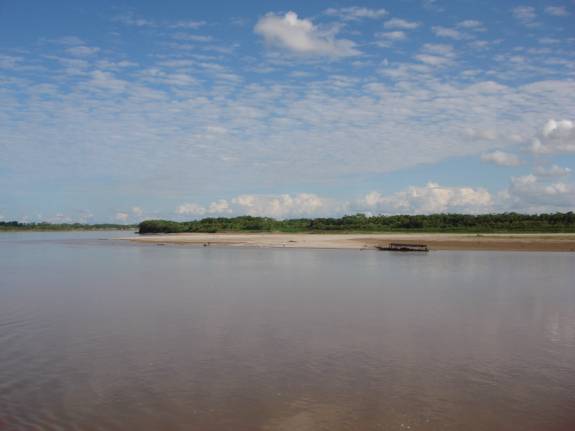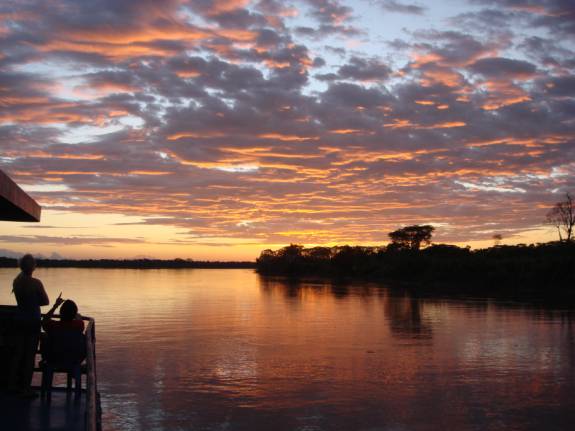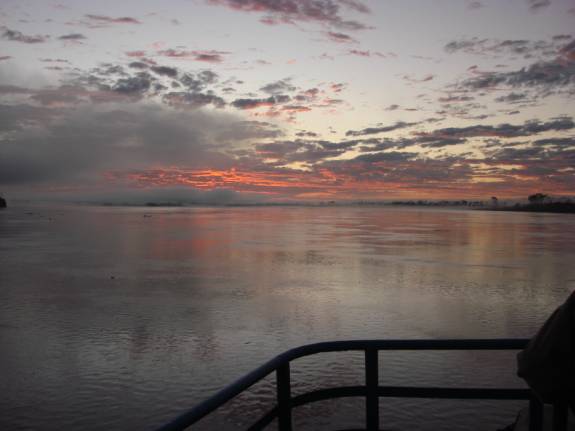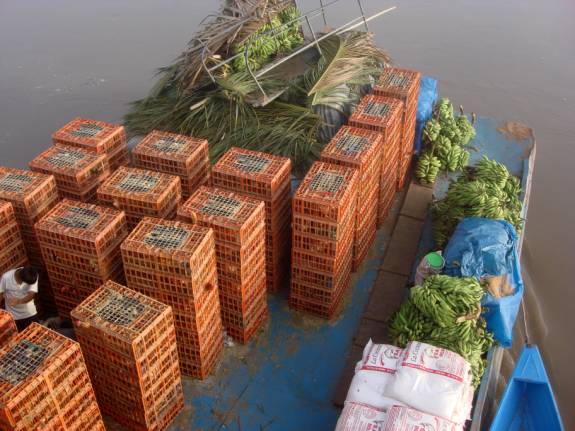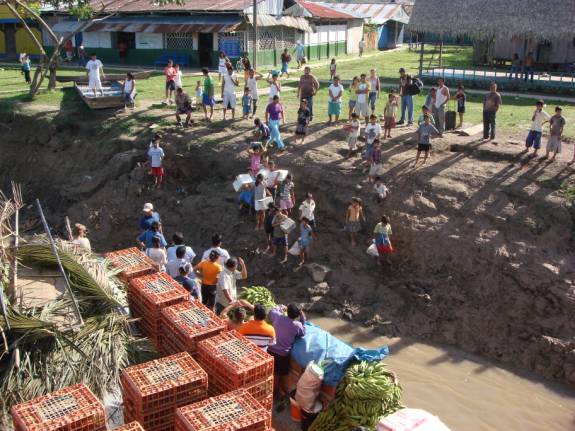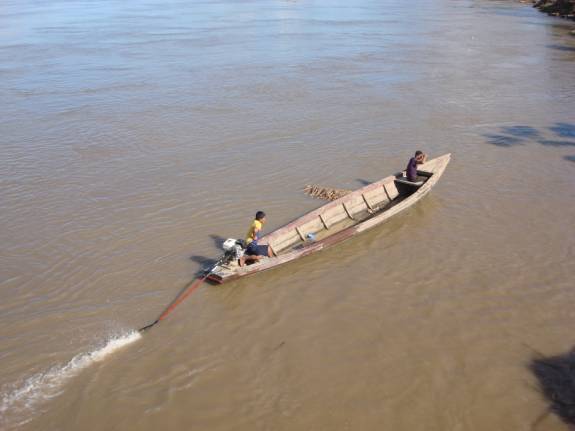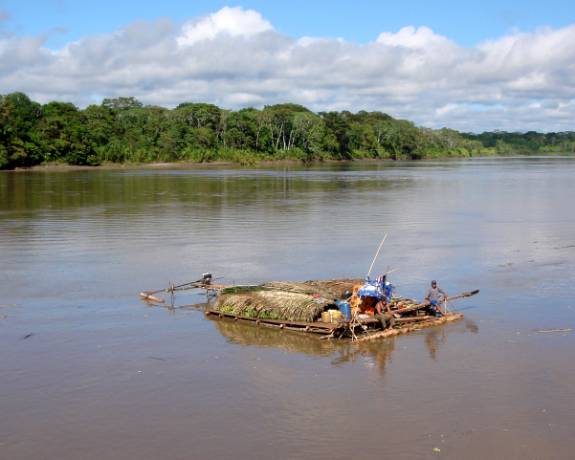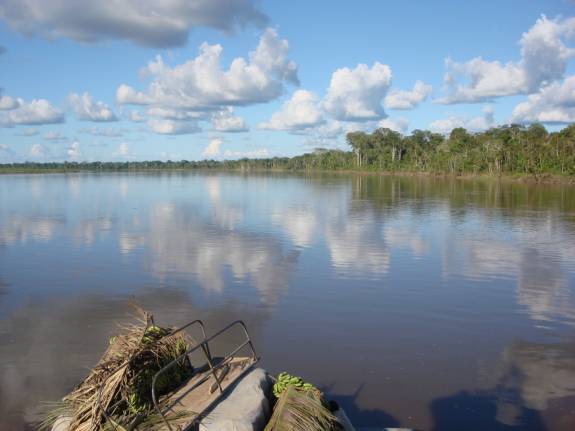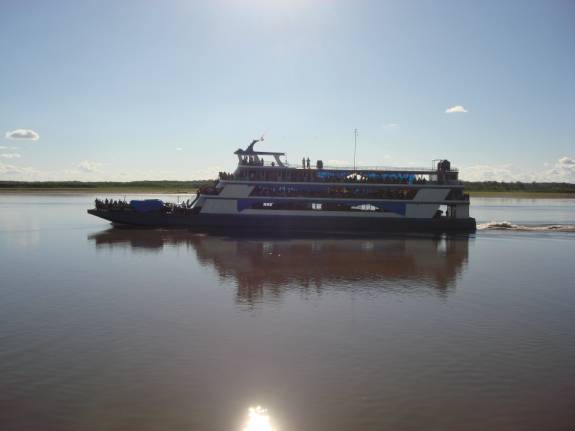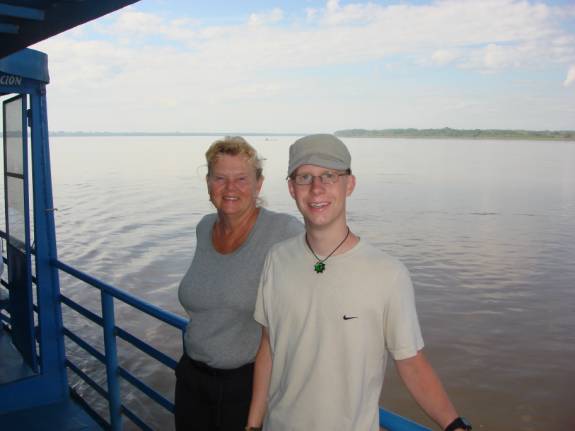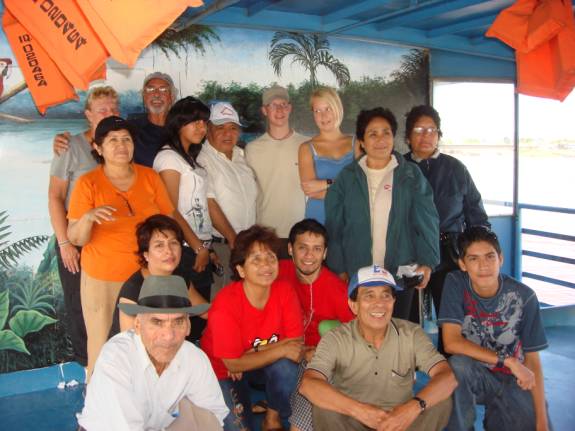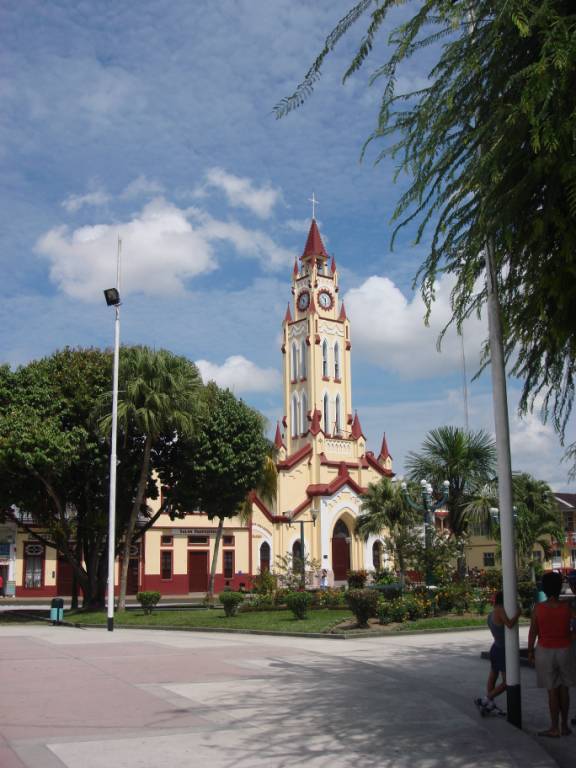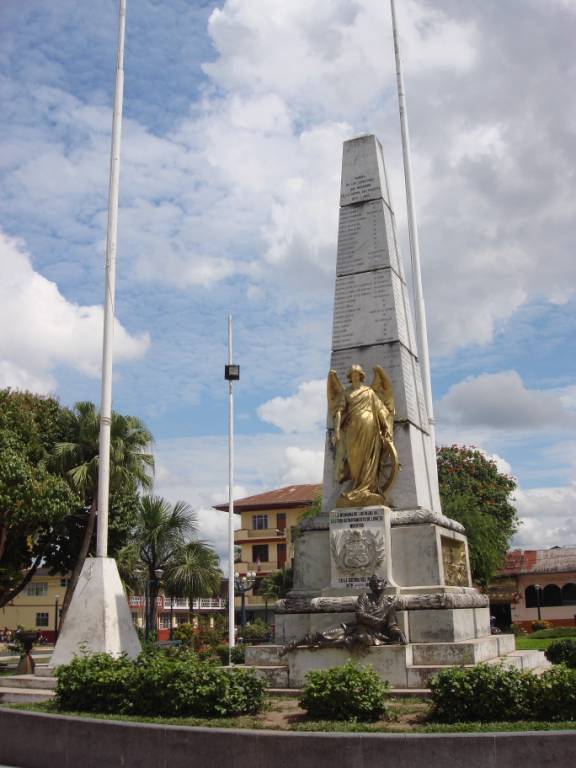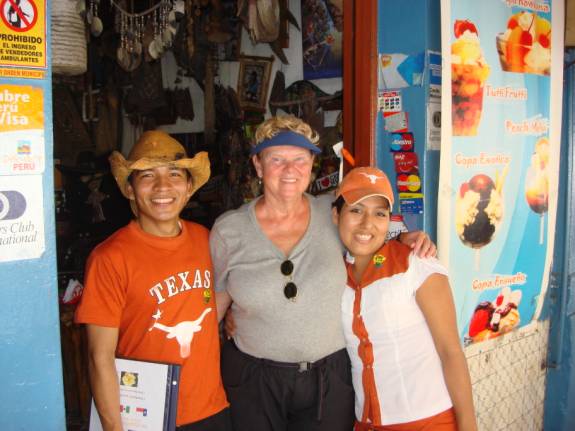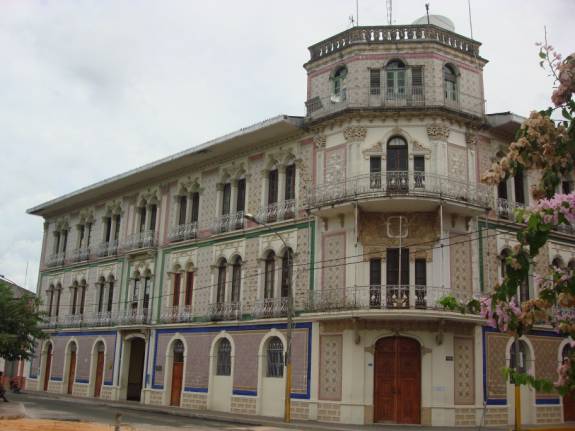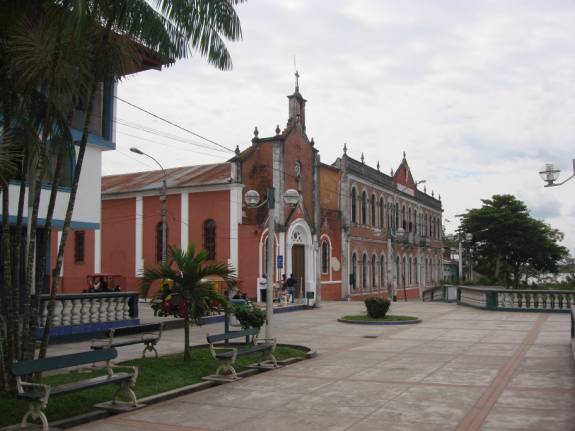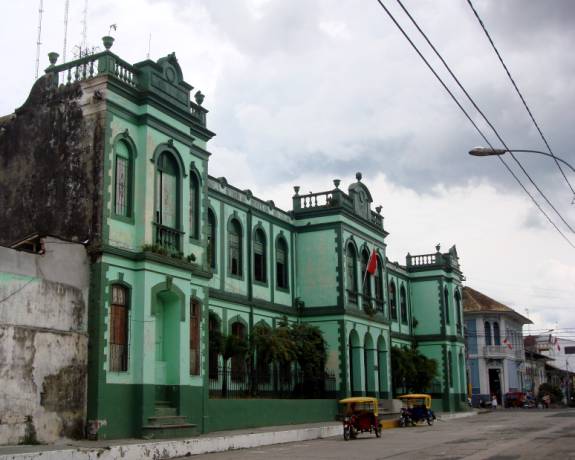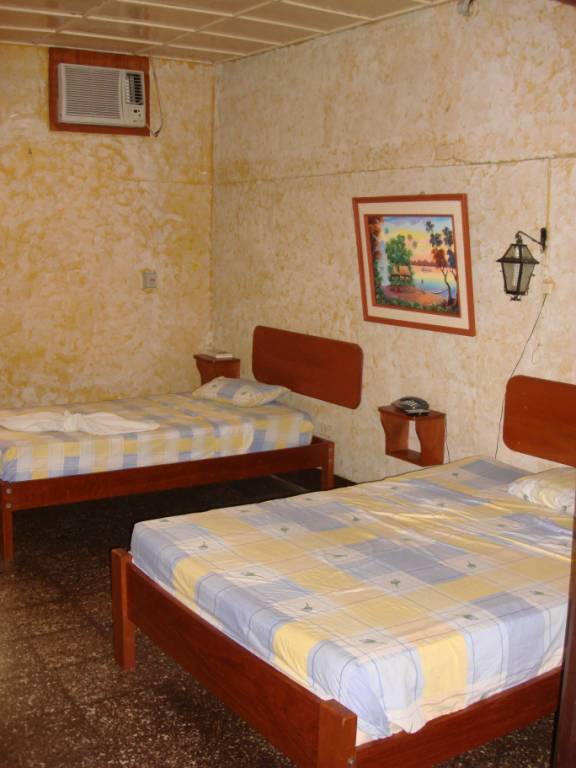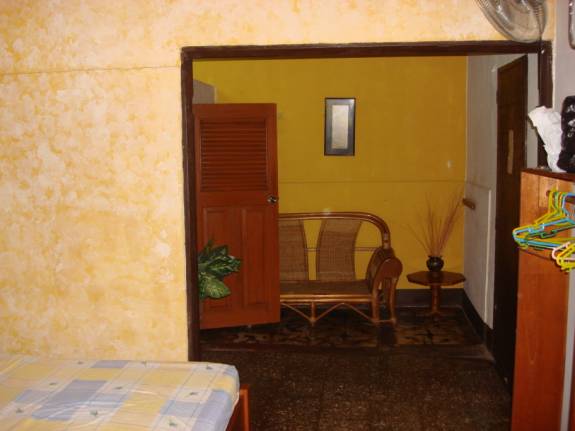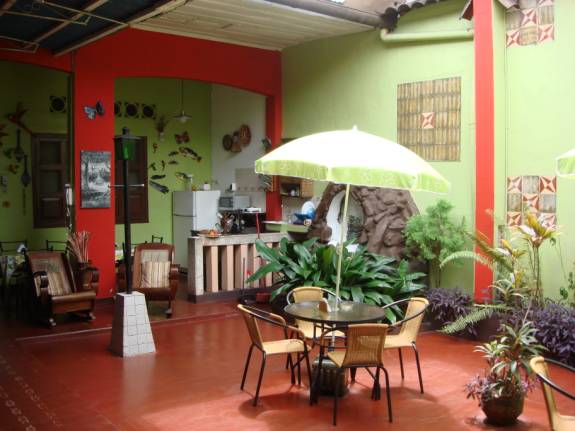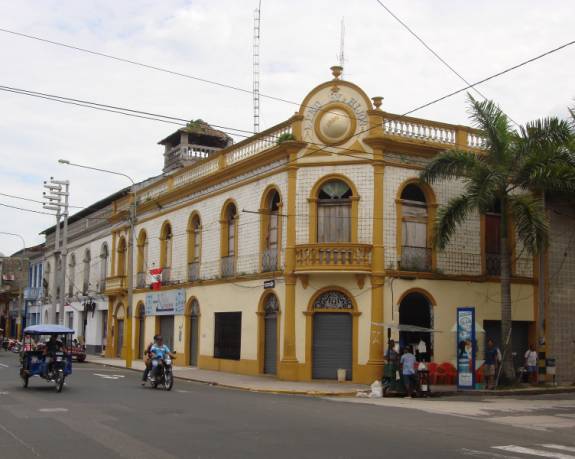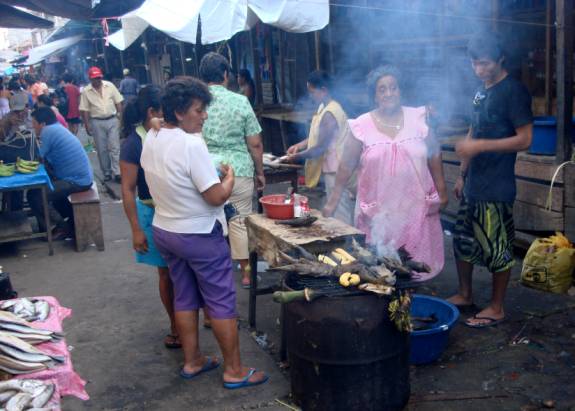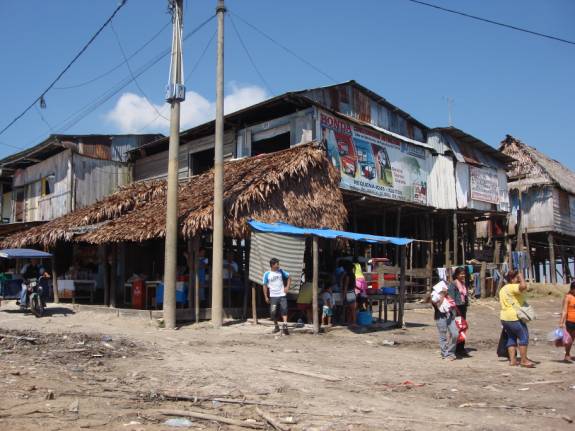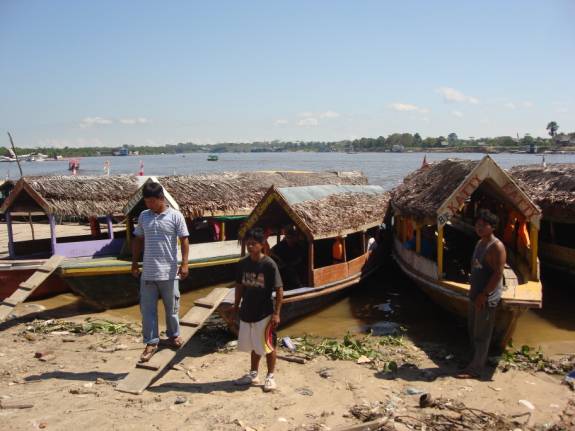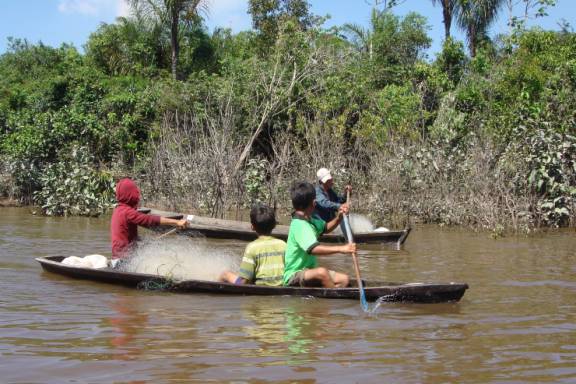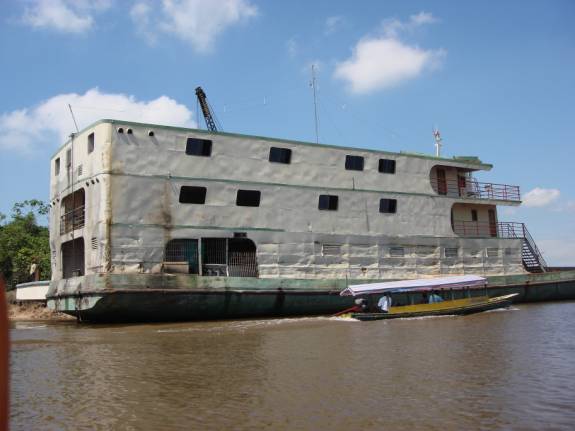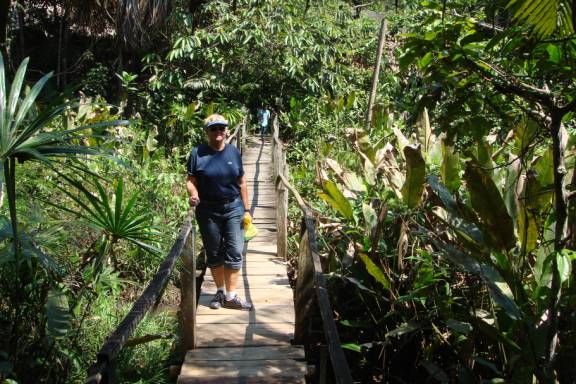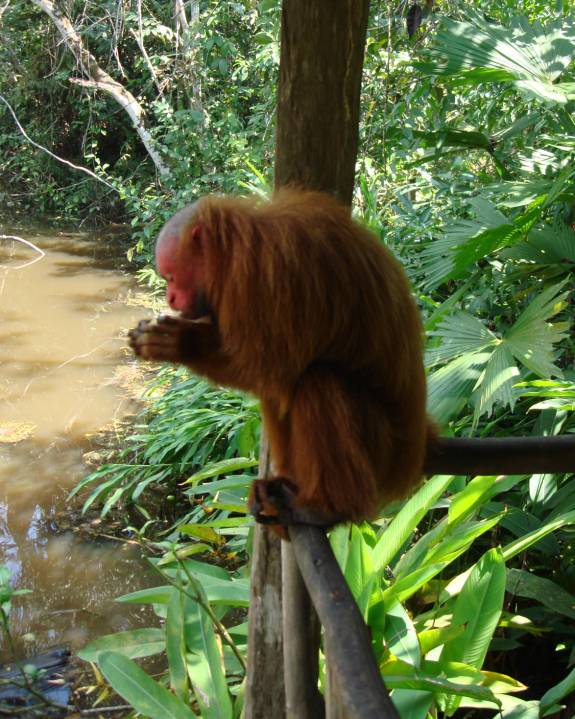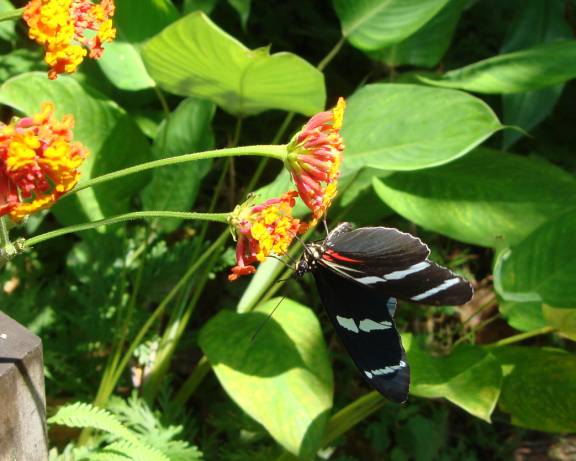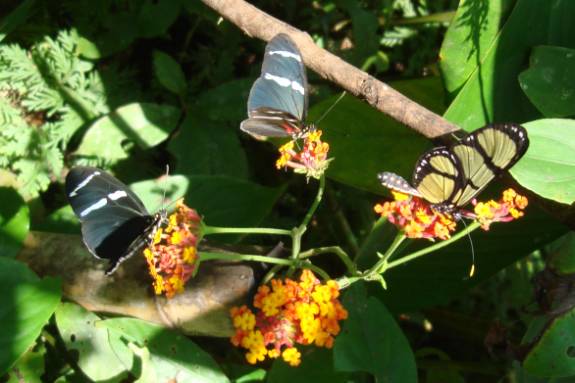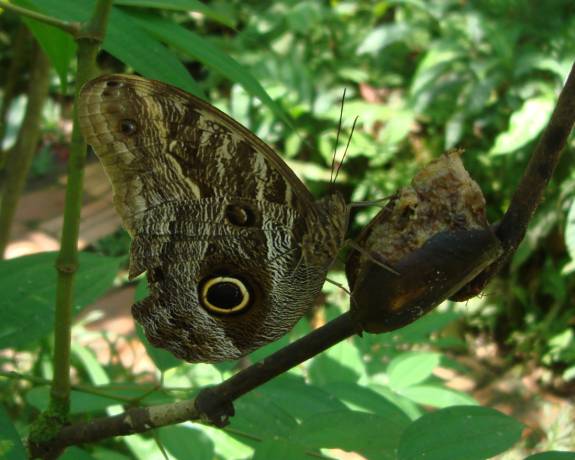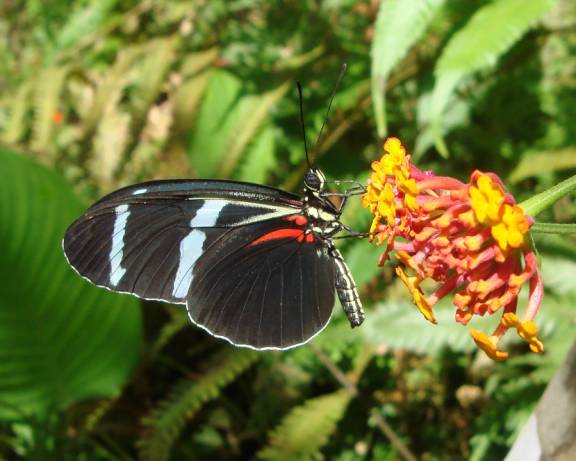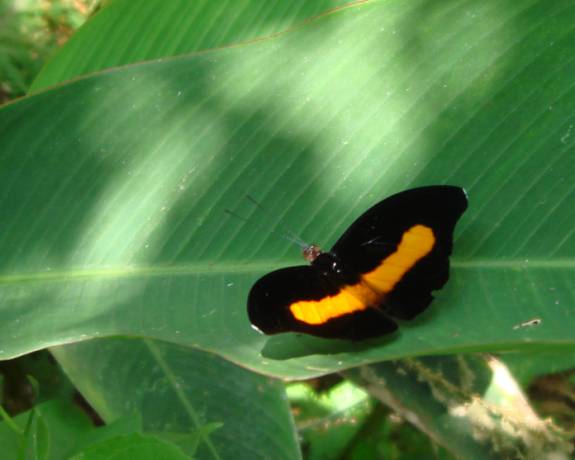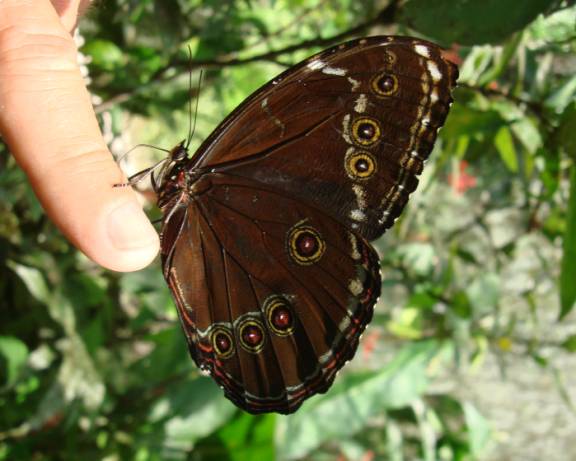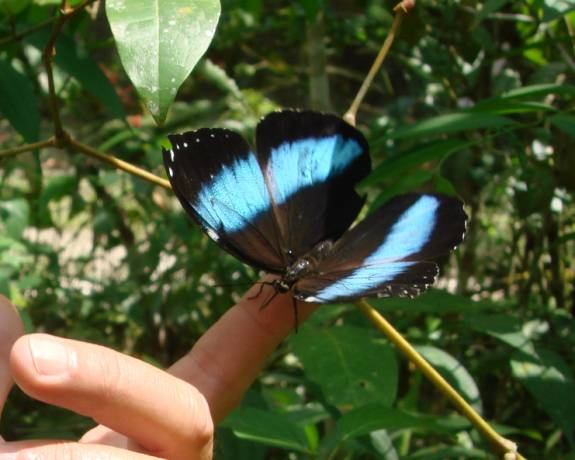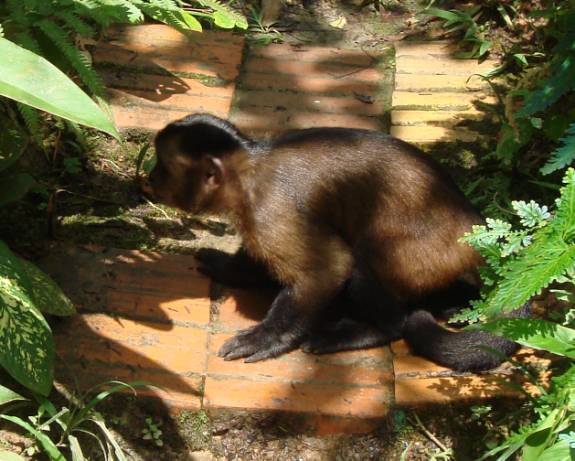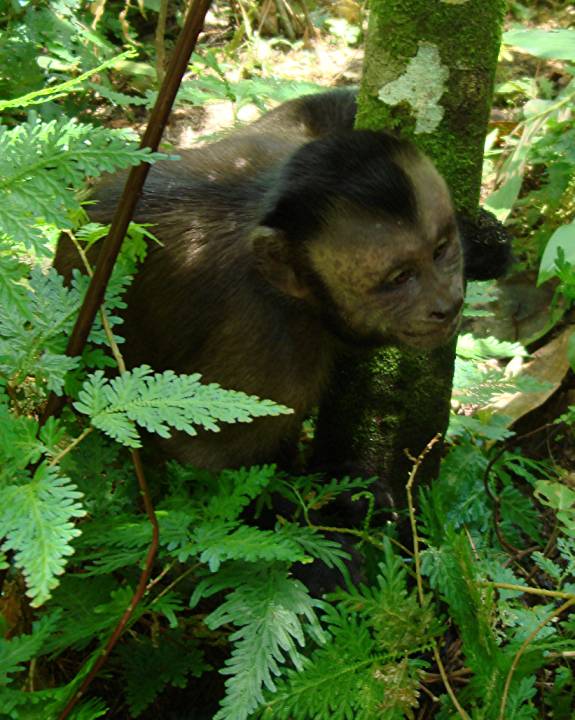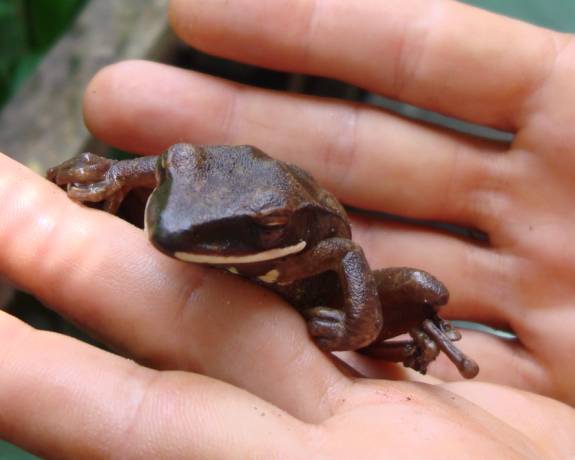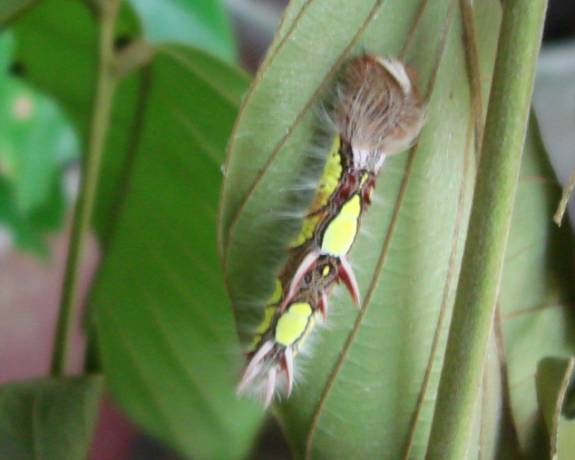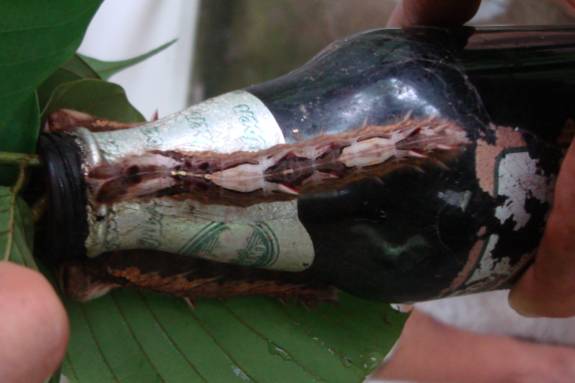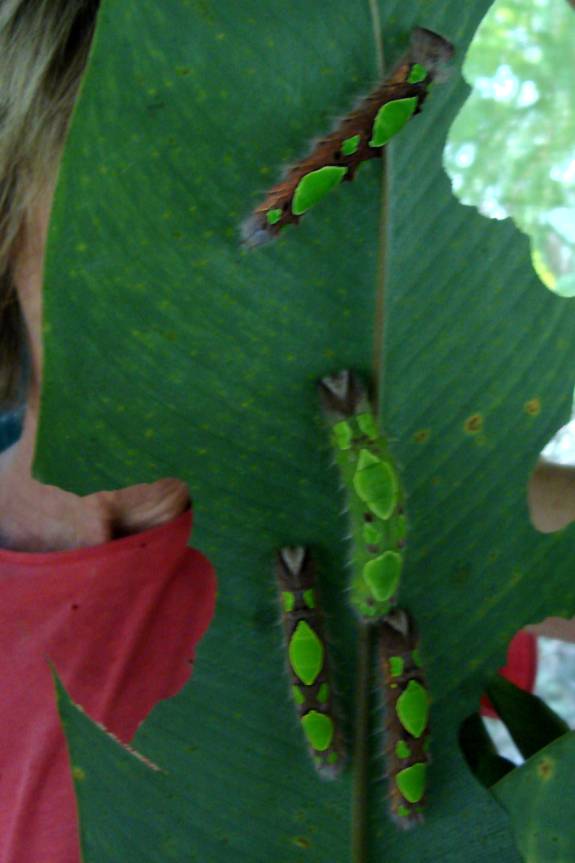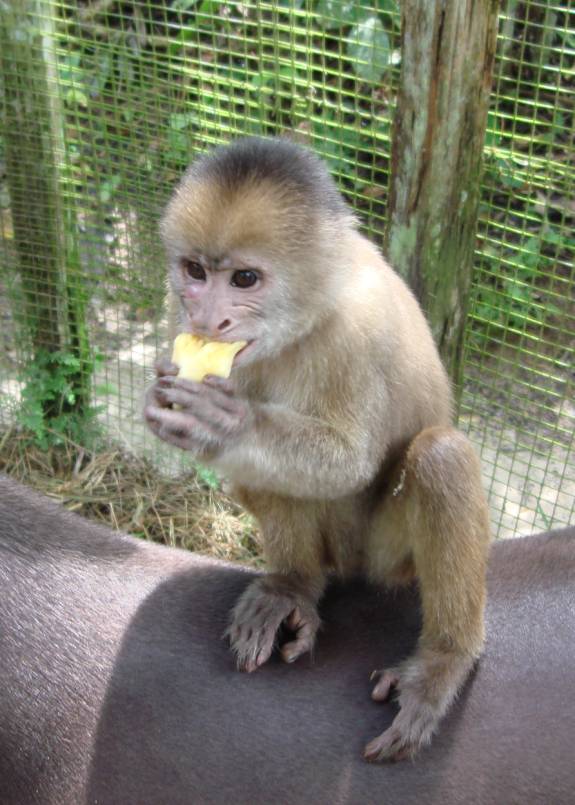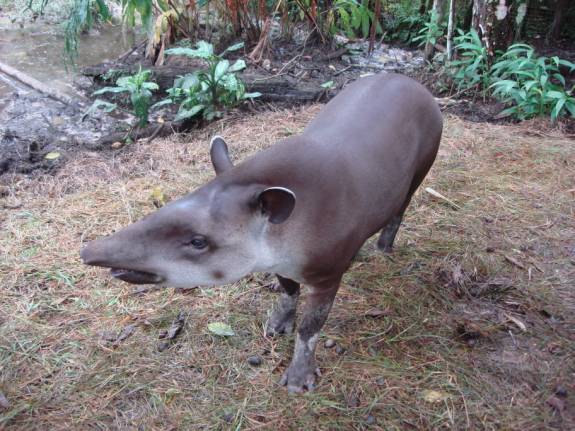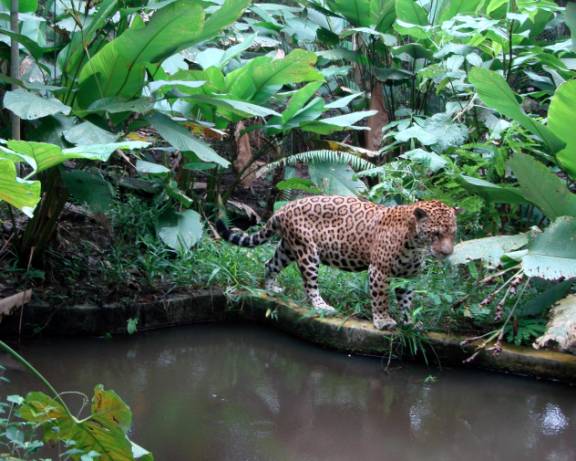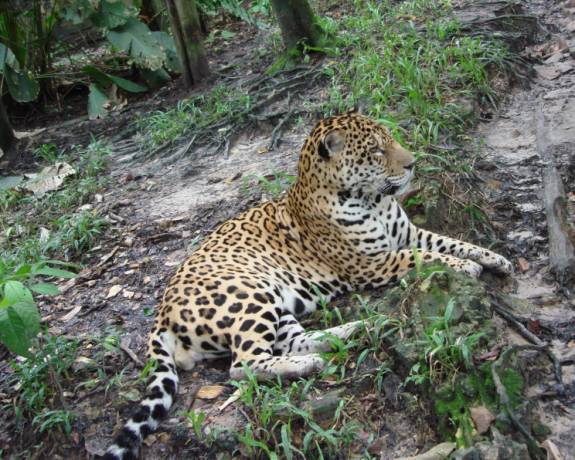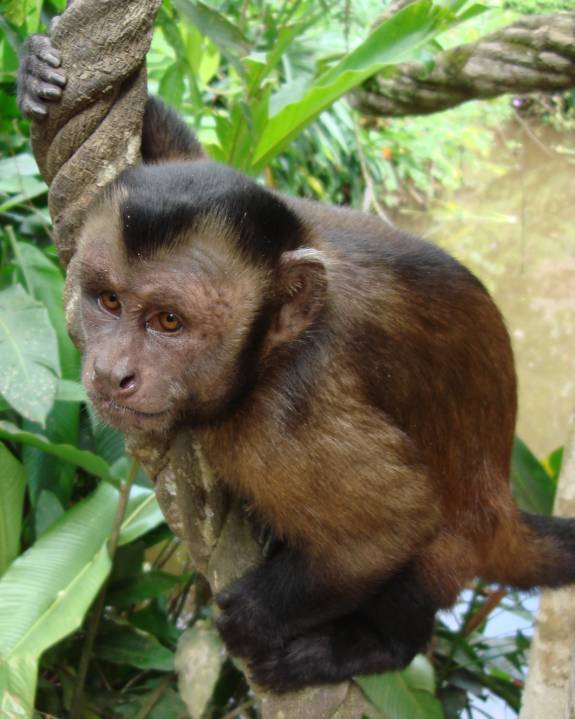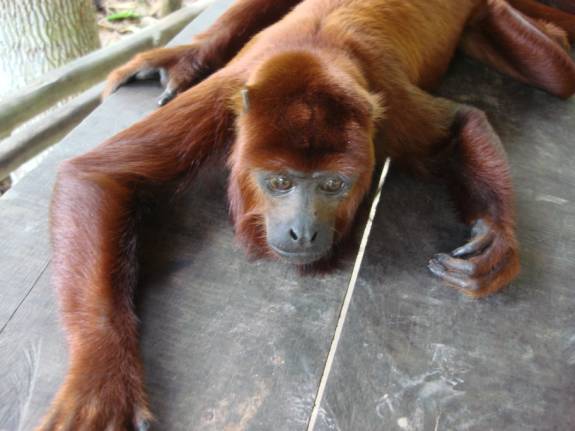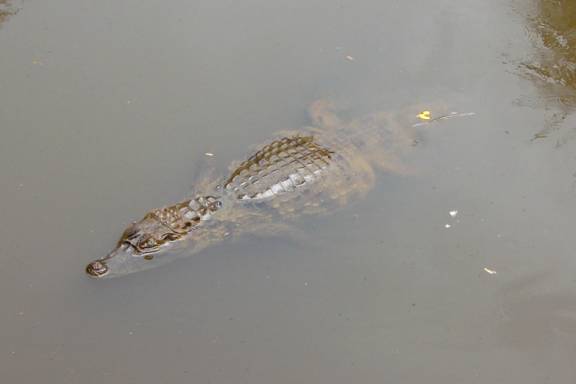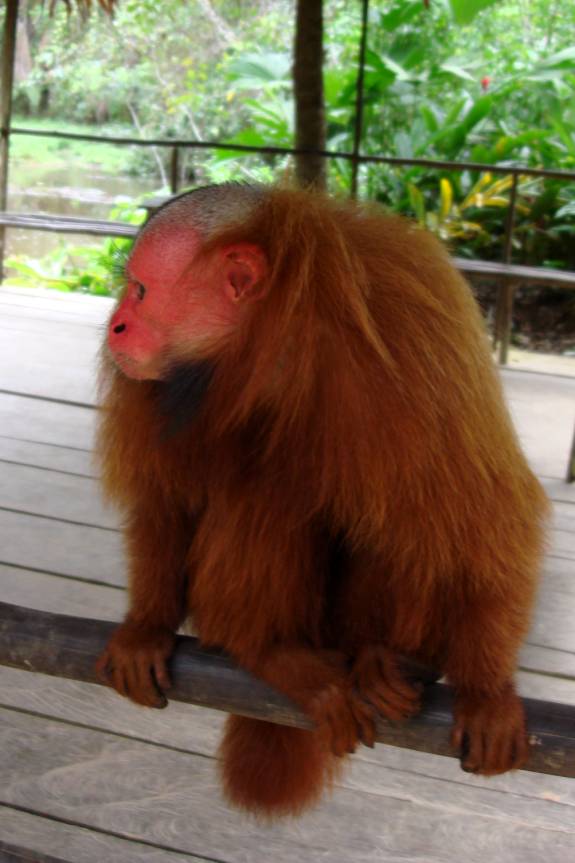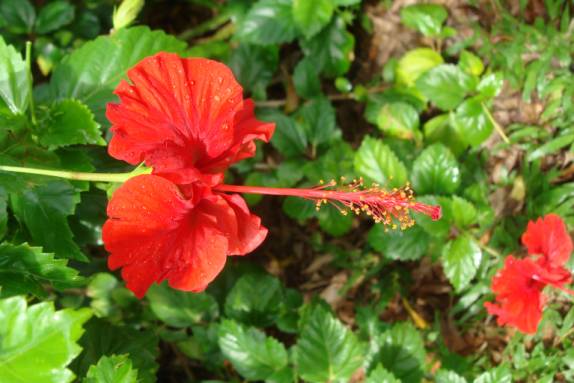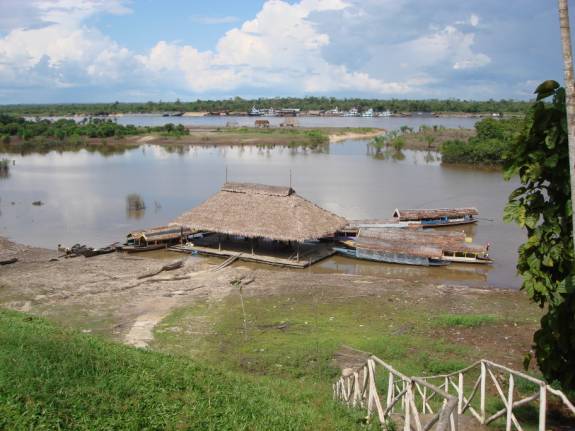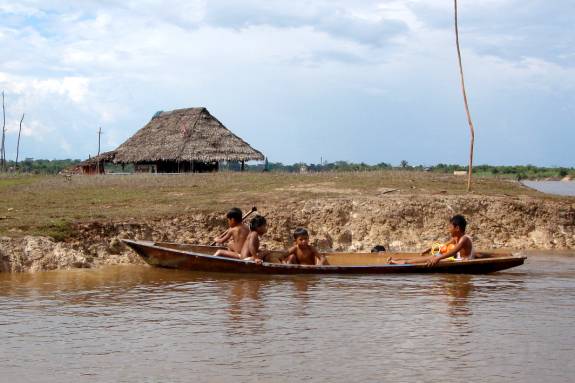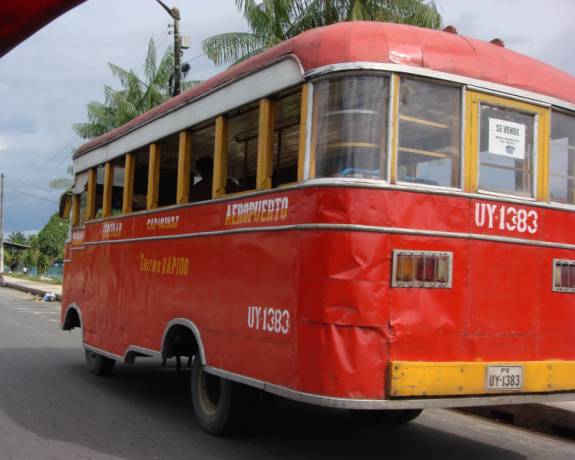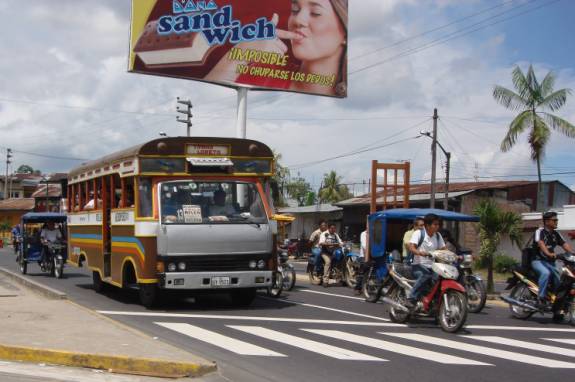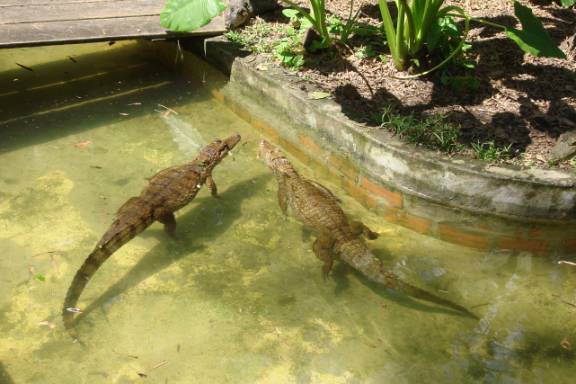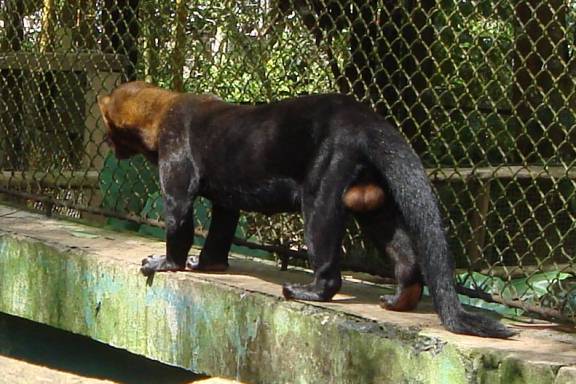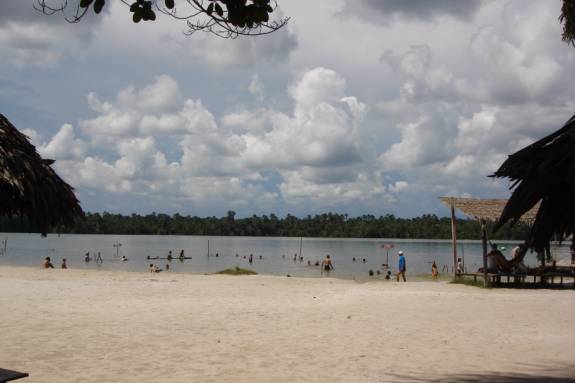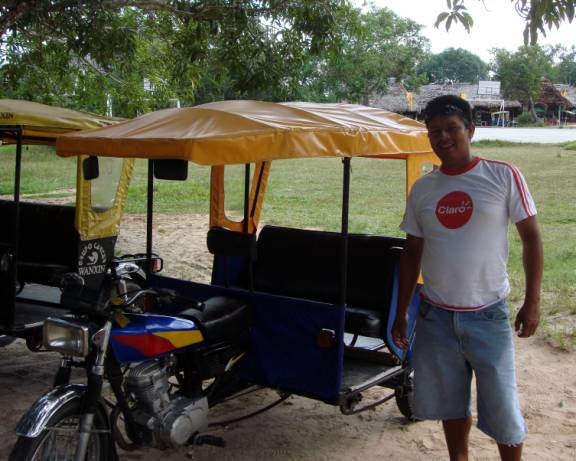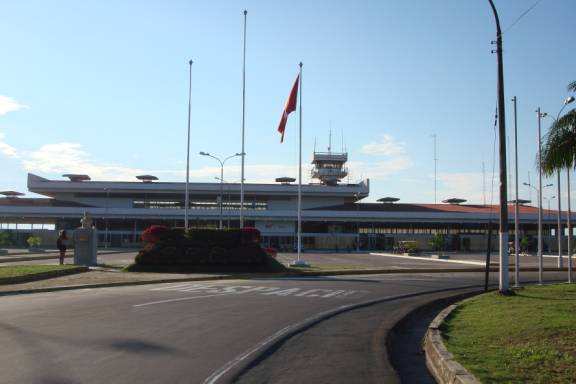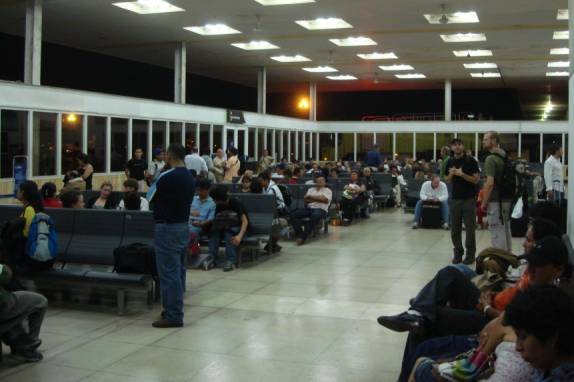|
|
|
|
Site Index:
|
UPDATE#26
07/27 thru 07/31
Howdy Everybody, The adventures of 2006, 2007,
2008, and 2009 through 07/26/09 have been published on the website.
We continue with the latest edition, which is the 7th in the
Peru Series. UPDATE 2009 #26
07/27/09 thru 07/31/09 At last update, we were aboard
the EDUARDO III awaiting the departure to travel down the
Amazonas rivers from
Yurimaguas to Iquitos, Peru. 07/27/09
MONDAY YURIMAGUAS, PERU
aboard EDUARDO III
At 6:45am, the EDUARDO III
started moving. Judy and I were
somewhat surprised, as we had not expected this early departure.
Of course, I had to be on deck as soon as possible.
Now I was even more surprised as it appeared that we were headed in the
wrong direction and going upstream. I
resigned myself to thinking that, “oh well, they must know what they are
doing”.
Along the banks of Yurimaguas,
hundreds of riverboats of varying types and sizes lined the shore.
We motored past this banana
raft floating in the opposite direction.
The GILMER I had pulled away
from the same bank and was headed in the same direction. After about an hour, both cargo boats drove their bows into
the mud banks, side by side. It was
now obvious that we would be taking on more loads from this location.
On the bow of the GILMER I, an enterprising fellow was selling fresh fish
to the locals.
There were vendors selling
small goods and food. At one of
them, Judy and I had a bowl of soup and a couple of empanadas (meat pies).
Our Captain, Rafael, was in his
full dress uniform. It was the
first time we’d seem him in full regalia.
He must have wanted the added respect and recognition due his command
authority when dealing with port officials.
As soon as we left port, he changed back to his casual clothes and we
never again saw him in his official Captain’s attire.
At the river landing, more
cargo was loaded and lots more people got on board.
We hadn’t dared to stray far from the boat because we couldn’t get
any information about when we would continue.
At 10:45am, the EDUARDO III eased back into the river and headed back
downstream.
Several large rivers eventually
feed the mighty Amazon River. We
begin our travel on the tributary called the Rio Huallaga. “Rio” means “river” in Spanish.
The small dining room on the
upper deck was being setup for our dinner.
Meal service is only for the upper deck passengers.
Passengers on the lower deck must take their own bowl to the feed line.
Our river journey started in
Yurimaguas on the Rio Huallaga. The
source of the Huallaga River originates on the slopes of the Andes in central
Peru. Downstream and ahead of us,
the Huallaga joins to become the Marañón River, later joining and becoming the
Ucayali River. Those joint river
waters and forces combine to form the mighty Amazon River. The EDUARDO III will navigate all these waters before
reaching Iquitos.
The once empty upper deck must
now be shared with lots of other travelers.
We were the only two from the United States.
Most were Peruanos
and there were only a couple of Europeans and an Argentine woman.
Fred Reed and Judy Law aboard
the EDUARDO III somewhere on the Rio Huallaga in Amazonas, Peru.
Red sky at night, Sailor’s
delight…
When dinner was served, the
meal consisted of chunks of stewed chicken accompanied by some vegetables and by
rice drizzled with a nice, red pepper sauce.
It was quite tasty.
During the night darkness, the
boat edged up to the banks and additional cargo and passengers were loaded at
several towns. The waters were
smooth, the air was pleasant, and the boat’s engines were relatively quiet.
Wherever florescent lights lighted the decks, there was a swarming of
insects. Fortunately, our section
was not in the direct light and they did not overly bother us.
We relaxed in the hammocks until midnight before retiring to our room. 07/28/09
TUESDAY AMAZONAS
RIVERS aboard EDUARDO III
On July 28th of each year, the
people of Peru celebrate “Fiestas Patrias”. The important holiday commemorates the day that Peru gained
its independence. It honors the day that General José de San Martín, known as
Peru's liberator, proclaimed Peru's independence. I went around wishing to each Peruvian, “Feliz Fiestas
Patrias”. Their responses always
included a greeting and a warm smile that clearly indicated their delight in my
rememberance. Later in the morning,
one woman gave me the gift of a Peruvian Flag pin that I proudly wore for the
day. Today, we had made a lot of
friends and gained their respect.
Partially shrouded in fog, the
sunrise was a beautiful sight.
A few more “whistle stops”
were made along the route. Each
time, the townspeople would gather at the banks.
Notice how they dug out the riverbank mud in stair step fashion to
accommodate the cargo boats.
A speedy launch was used to
tender small pieces of cargo and a few passengers to shore locations while the
big boat continued its journey.
Huge stalks of bananas, bags of
salt for preserving fish, and numerous coups for the hens occupied the foredeck.
A hearty breakfast was served
to the passengers of the upper deck. Because
of the small size of the dining area, they needed two separate seatings.
Another one of the short stops
in some small, riverside village...
Low power engines, similar to a
lawn mowers, power the long shafts of these boats.
Easily tilted, they can navigate in very shallow water.
Frequent sightings of banana
rafts evoke thoughts of Huck Finn and Tom Sawyer.
On the lower passenger deck,
the hammocks were strung closely together.
Quite crowded, they stowed all their belongings under their hammocks.
There were toilet facilities on this level but, unlike the upper level,
there were no showers or dining area. This
boat carries 250 passengers, most in hammocks on the larger, lower level.
On some occasions, the boat
would hug the shoreline seeking the deeper water.
Numerous, seemingly primitive,
small boats awaited at some of the stopping points.
The weather was perfect for
enjoying the river scenery.
Heading in the opposite
direction, a sister ship passed, presumably destined for Yurimaguas.
Between Yurimaguas and Iquitos, there are no roads.
All traffic must move via air travel or water vessels.
The lunch was a chicken dish,
similar to that served last night, with mushrooms, salad, and a local favorite
beverage called “chicha morada”. The
purple drink is made from fermented corn and is very sweet. I think it might be one of those “acquired tastes”.
Dinner was Pot Roast of Beef,
rice, and fried plantains. We were
fortunate to be in the first seating for every meal.
After dinner, I fell sound
asleep in the hammock for almost 3 hours. The
river has definite shallow areas. About
9:15pm, a sharp jolt definitively indicated that the boat gone hard aground.
Fortunately, the crew maneuvered the boat and it was freed quite easily. Some of the passengers were panicky and quite nervous.
Some of them donned their life jackets quickly, probably presuming the
worst.
About 11pm, the boat landed at
the town of Nauta. From here, the
road connects to Iquitos. Many
passengers disembarked here and continued by land, effectively shortening their
total trip time by about 8 hours. We
were enjoying the adventure of river cruising and were happy to stay aboard the
boat. What’s more, we were
navigating the famous Amazon River. 07/29/09
WEDNESDAY EDUARDO III,
AMAZON RIVER to IQUITOS, PERU
As the river widens, mud and
silt from the joining rivers settles out to create very shallow areas.
There was no depth sounding equipment on board to guide them.
To determine the areas of sufficient water, they sent out the skiff to
make soundings using a long pole with depth markings.
Much like it was done over a hundred years ago on the Great Western
Rivers of the US, the scouting pathfinders reported the “go or no-go”
results.
The sunrise over the Amazon
River was gorgeous.
Captain Rafael gave us the high-five. He constantly listened to this old transistor radio, the
likes of which I haven’t seen in decades.
I don’t know what he was listening to, but he obviously like it.
Do you think it possible that Peru has the equivalent of Rush Limbaugh?
We had the pleasure to meet and
chat with Pascal Gmuer. The young
Swiss fellow was extremely well educated, an avid adventurer, and his English
language skill were phenomenal. It
was a real joy to share the river trip along with him.
He plans to go deeper into the Amazon Jungle and Rainforest from Iquitos.
Most of these folks were
Peruanos traveling to Iquitos from the Pacific coast city of Trujillo.
We were well accepted and became friends during our journey.
Some were headed to a jungle lodge and asked if we would like to join
them. Although it might have been
fun, we gently declined their graceful offer due to time considerations.
We gathered for a group photo
as a reminder of newfound friends.
With the port of Iquitos in
sight, we knew that our adventurous river trip was nearing the boat’s
destination.
Scores of riverboats lined the
banks awaiting their next load. Some
would head for Yurimaguas, some toward Pucallpa along the Ucayali River, while
others would reach destinations further down the Amazon River toward Columbia
and Brazil.
A MotoTaxi took us from the
port area to the central district of Iquitos.
Iquitos is the largest city
in the Peruvian rainforest and home to a population of almost 400,000
Amazonians. The Department Capital is the most populous city in the world that
cannot be reached by road.
The Matriz Cathedral was
beautifully designed and, during
a period of thirteen years from 1911 to 1924, it was built adjacent
to the central Plaza de Armas.
An obelisk monument
memorializes those from Iquitos who defended Peru in the War of the Pacific in
1879.
An interesting find in Iquitos
was the Yellow Rose of Texas Restaurant and Bar.
Dressed in UT colors, the wait staff has adopted the friendly ways of
Texans. Although we only had coffee this morning, the tempting menu card made us
promise to return.
Iquitos was thriving in the era
of the rubber boom from about 1880 to 1912. The Iquitos region was the
world's foremost source of raw rubber and vast fortunes were amassed. Numerous
attractive buildings, constructed during those wealthy times, were adorned with
elaborate ceramic tiles imported from Italy and Portugal.
With the recommendation from
some local passengers on the boat, we chose the Hotel La Casona for
accommodations. Well situated
near the center on Avenida Fitzgarrald, it was an ideal and economical (less
than $20/night) option for our visit. Our
room was large, quiet, clean, and comfortable.
What more could we want?
It had a separate sitting area,
however, we were not planning on spending much time in the room other than to
shower and sleep.
A courtyard area was available
for guest cooking and eating. Especially
in the morning, it was a convenient alternative for coffee and a light
breakfast.
Another example of those
famous, decoratively tiled buildings from the Rubber Era…
We walked through some of the
famous Belen market area. Being a
holiday and an off-market day, many of the vendors were closed. This woman was grilling whole fish over a charcoal-fired
barrel.
The central Plaza de Armas is
viewed as a hub of the city’s social life. Tonight, large numbers of the
local populace were gathered to continue the celebration of Fiestas Patrias.
Nicely lit up, many of the
shops and buildings around the Plaza de Armas are very attractive.
07/30/09
THURSDAY IQUITOS,
AMAZONAS, PERU
Wanting to get an early start,
we had our coffee and a few packaged donuts at the hotel.
After dropping off laundry, we took a MotoCarro (that’s what they call
the MotoTaxis here) to Puerto Nanay. From
this port, we would board a “launcha
colectivo”, (collective boat).
The boat boys directed us to
the appropriate launch.
This launcha would take us on
the tributary river, Rio Nanay, to a village called Padre Cocha.
Out on the Rio Nanay, we got to
see the amphibious plane that takes the wealthier folks out to the expensive,
resort lodges of the Amazon.
It almost looks like a race
between the kids and a man to see who will reach their favorite net-fishing area
first.
This old cargo boat has had a
rough life. Looking at the battered
steel sides, we could only imagine how much cargo had been shipped in her hold.
Similar to the boat we were on,
this launcha colectivo was being powered by one of those long-shafted,
air-cooled mower motors. The one we
were on had an almost new Honda motor with the extended prop shaft.
The village awaited just beyond
the thatched roof dock…
We had about a 20-minute walk
to the reserve. It was interesting
walking through the remote little village. Using similar materials, designs,
and techniques, small boats have been handcrafted by the locals for generations.
We were here to visit the
Amazon Animal Orphanage and Pilpintuwasi Butterfly Farm.
The unique preserve is the only butterfly farm in Peru.
Over 40 species of the most
colorful “Mariposas” (Butterflies) existing in the Amazon Rainforest are
said to thrive here at the Pilpintuwasi Reserve.
I think this one is called, “Chavo”;
He is a Red-Faced, Bald Uakari Monkey…
The butterflies were
everywhere…
This is an owl butterfly. In a
later picture, you will see it with wings spread…
Blue Morph butterfly with wings
folded…
Blue Morph butterfly with wings
spreading…
For a butterfly, this piece of
fruit is fine dining…
Howler monkey…
Howler monkey…
Ribbit, Ribbit….,
Being lone travelers, we were
treated to a special tour of the facility by Gudrun Sperrer. Born in Austria, she has lived in the Amazon Rainforest since
1982. Gudrun is the founder,
caretaker, animal handler, and a well-known “lepidopterologist”(butterfly
scientist). For nearly an hour, she
introduced us to the world of butterflies and informed us about their
lifecycles. She took us around to
meet many of the jungle animals housed at the reserve.
Knowing just how to gently hold
this living specimen, she gave an up-close and personal look at the fascinating
“tattered winged Búho”
or “Owl butterfly”. The “búho”
(owl), got its name from the large, dark spots on its shapely wings that
resemble an owl’s eyes. They are one of the few aggressive species. With
barbed feet, they rip at each other’s wings to defend their pieces of fruit,
leaving most with torn wings. Isn’t
it amazing how nature has given these creatures some amazing defensive
mechanisms and colorations?
We learned that each species
needs a specific plant leaf to propagate. Gudrun
explained some of the many problems in finding the necessary host plants for
each caterpillar and then protecting it from predators, including her own
monkeys.
In the chrysalis house, various
living specimens hang from their host leaves.
After mating, the female
butterfly lays her eggs on specific “host” plants." After the larva
hatch from their eggs, they voraciously eat the plant leaves. After only a few
days, a caterpillar hatches and they continue eating and growing rapidly. The
caterpillars of different species need between 2 and 10 weeks to reach their
mature size. During that phase, the caterpillar will sheds its outer skin 4 to 6
times.
Finding a secure place, the
caterpillar hangs itself with a silk-like pad, envelops its body in a hard case
shell, and turns into a ‘pupa’ or ‘chrysalis’. From within its pupa
shell, it undergoes complete metamorphosis and is transformed into a completely
different creature, the beautiful butterfly. Dependant on species, this process
may takes from one week to several months.
When the fully developed
butterfly emerges from the chrysalis, it is able to fly and the reproductive
process begins again. The normal
life span of an emerged butterfly is usually less than two weeks.
Cappuccino monkey…
Gudrun affectionately called this one, “the bitch” because she gets
into so much trouble. If she gets
into the chrysalis house, she can destroy months of painstaking work in minutes.
This monkey is also infamous for picking peoples pockets.
A tapir…
Pedro Bello, the magnificent
Jaguar…
Rosa, the anteater…
Howler monkey… Actually, I think he looks a lot like one of my
friend’s second cousin…
I think this is a type of
spider monkey…
A South American
“caiman”…
A “bald Uakari”…
A
“Scarlet Macaw” and a “Blue-and-Yellow Macaw”
This mischievous Howler monkey
loves to untie shoelaces. As soon
as you retied them, he’d pull them open again…
After a delightful experience,
I was very impressed with what Gudrun has done, and is doing, at the preserve.
I cheerfully added a monetary donation to help her work.
Another 20-minute walk brought
us back to the Padre Cocha dock on the Rio Nanay.
In the Amazon region, the ways
of boating and fishing become a basic part of life at a young age.
Unique to Iquitos, unusually
styled buses, like this open-window model sporting wooden frame posts, regularly
zip along the urban routes.
La Casa de
Fierro
(The Iron House) was reportedly designed and built by Frenchman, Gustav
Eiffel, of The Eiffel Tower fame. Originally built in France, the building
was disassembled and shipped via the Amazon River to Iquitos following the Paris
Exhibition of 1898.
As a reminder, travelers to
South and Central America need to learn and practice the skills of bargaining.
It is a common occurrence for almost every vendor and taxi driver to
quote high prices. It is a way of
life. It is expected that you will
bargain for a better price. Too many travelers just accept what is first said, like they
would at home. Although the seller
will gladly take it or more, what they won’t have is any respect for you.
To them, you are considered a “fool” and ignorant.
What they feel is that they have just taken you and your money.
Perhaps the dollar amount is relatively insignificant, but what value
have you lost when you lose their respect.
OK, off my soapbox…
With another full day planned
in Iquitos, we made arrangements to fly back to Tarapoto at 11:35am Saturday
morning on LC Busre Airlines. We
had paid cash and were told to come back later to pick up the paper tickets.
When we did return, they informed us that the flight had been cancelled
for tomorrow and that we could either fly another day or pay a bit more for a
later flight on Star Peru Airlines scheduled for 6:35pm Saturday evening.
Gaby helped us rush over to the other airline office just before they
closed. We had to pay again, this
time using a credit card. Gaby said
that they would refund our cash tomorrow because the bank was closed now and
they had already deposited it. We
reluctantly understood and agreed to return tomorrow.
Normally, we don’t fly from
city to city. We prefer to use land
travel because we enjoy more of the countryside and the people.
With Iquitos so far away by boat only, we felt justified saving almost
another week of travel time by flying.
For dinner, I decided to get
some ingredients and cook our own dinner in the “cocina”(kitchen)
of the hotel. Italian food was
selected for our personal menu. I
don’t think we could have had a more enjoyable or intimate dinner anywhere. 07/31/09
FRIDAY IQUITOS to
TARAPOTO, PERU
The morning started with coffee at the hotel.
Having perused the great menu before, we walked over to “The Yellow
Rose of Texas” restaurant for breakfast.
The owner, Gerald Mayeaux, moved here after retiring from a
petroleum-engineering career in Houston and married a Peruvian gal.
As a UTA baseball player and graduate of the University of Texas –
Austin, he kept his loyalty strong. With
a UT theme, he opened the Yellow Rose of Texas.
Although the prices were a bit higher than we usually spend, the food was
absolutely fabulous and we were glad we chose the place.
Judy had the giant, Texas-sized French Toast.
I chose their delicious offering of Plato de
Frutas (fruit plate).
We bargained with a MotoCarro driver to take us, wait, and bring us back
from Laguna Quistococha and the zoo.
Of the five freshwater species of dolphins in the world, the pink Amazon
River dolphin is considered to be the most intelligent. Although they
claimed that this was indeed a pink dolphin, it looked a bit more gray to us.
At the zoo area, there were lots of pools with caimans, turtles, and
other aquatic creatures…
Could this be a black Puma? I
really don’t know for sure…
The lake (Laguna Quistococha) has an interesting folkloric history.
According to ancient legend,
there was a mysterious island located in the middle of this beautiful lake.
The island was believed to be cursed by evil spirits.
Many brightly colored macaws lived on the island too. Whenever
something bad happened at the nearby town, the macaws would start squawking and
the island would move with powerful earthquakes caused by the evil spirits.
An ocelot…
I was challenged to hold this Boa Constrictor snake…
A Blue-and-Yellow Macaw…
Our MotoCarro driver was faithfully waiting to return us to the center of
Iquitos.
We had stored our luggage at the hotel so we had time for a relaxing meal
at a café near the Malecón
(riverwalk). At 4:30pm, we picked
up our bags, hailed a MotoCarro, and headed for the Iquitos airport terminal.
Air travel to this city is very important since there are no roads
leading in or out of the area. Everything
is modern and check-in was fast and efficient.
There is an old saying, “With time to spare, go by air…” The Star
Peru flight was scheduled for 6:25pm. The
airline didn’t change their time board even when they knew the flight was
running late. We were required to stay outside of the secure area until the
plane arrived. Once cleared through
security, the waiting room was spacious and comfortable.
In a 4-engined, BAE 146, we departed at 7:40pm for the 1 hour, 20 minute
flight.
After arriving well after dark in Tarapoto at 9pm, we refused the
expensive taxis and bargained with a MotoCarro driver to take us to the center.
Hoping to stay at the Hostal San Antonio, we were turned away because
they were fully occupied. I asked
for a recommendation and was told to try the Hotel La Mansion.
The driver knew of it and took us there. After a bit of hard bargaining, we were given the keys to a
very nice room. We strolled around
the Plaza area and found a nice café to have fancy ice cream. We were somewhat surprised that there was no hot water
tonight, so the cool showers invigorated us.
Tomorrow morning, we will try to find onward bus transportation as we
head for Ecuador. CONTINUING
UPDATES OF OUR PERU AND ECUADOR ADVENTURES ARE IN PROGRESS… WATCH FOR MORE OF THIS SERIES COMING SOON… POST SCRIPT:
We sincerely hope that you will review the previous years of compilations
to give context to the current editions. Please
let us know if you have any special suggestions and thoughts.
REMEMBER: The website
is now fully active and you can visit it at any time.
You can also review any of the previous logs from the years 2006, 2007,
or 2008 and learn more about the crew and their many adventures.
Enjoy. ATTENTION:
SPECIAL NOTE:
You may contact us via email anytime. Thanks
for allowing us to share our life and adventures with you. Lotsa
Luv, Fred
Reed and Judy Law AMARSE MT40 "AMARSE"
is pronounced "AM-ARE-SAY".
Our
website is: www.amarse.net .
|
|
Fred H. Reed |
www.amarse.net © 2006 2007 2008 2009 2010 2011 |

